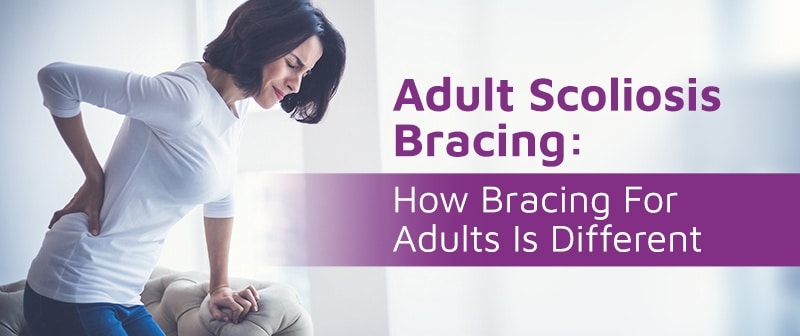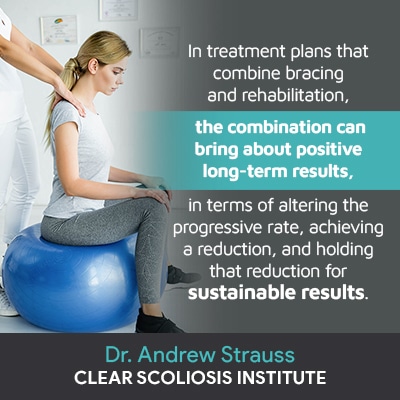
While most people think of scoliosis as most commonly affecting children and adolescents, scientific studies reveal that adults are more likely to develop the progressive spinal condition. Treatment goals for adult scoliosis include pain reduction, postural correction, curve stabilization, and, in many cases, modest reductions in the curvature. When a well-designed corrective brace is used in combination with a scoliosis-specific exercise program, it can help achieve the best patient results.
In the past, bracing in scoliosis treatment was most commonly used for children and adolescents; since 2016, scientific literature has shown it has a place in the treatment of adult scoliosis. As part of an effective rehabilitation program, a corrective brace can help impact scoliosis structurally.
Before we move on to addressing the specifics of scoliosis bracing for adults, and the difference in bracing for adults and children, let’s first touch on the two main forms of scoliosis that affect adults.
While scoliosis is far more prevalent in children and adolescents, with adolescent idiopathic scoliosis (AIS) being the condition’s most-prevalent form, adults can also suffer with an abnormal sideways spinal curvature, with rotation.
The two main forms of adult scoliosis are adolescent scoliosis in the adult (ASA) and degenerative scoliosis, also known as ‘de novo’. These two primary types have different characteristics and varying treatment needs.
Idiopathic scoliosis has no single-known cause and is instead generally considered ‘multifactorial’, meaning its causation is understood as the result of multiple factors.
As mentioned, adolescent idiopathic scoliosis is the condition’s most prevalent form in children, and as an incurable and progressive condition, scoliosis never truly goes away. Other forms of scoliosis found in children include infantile, juvenile, neuromuscular, and congenital.
For parents of children and adolescents diagnosed with idiopathic scoliosis, the benefit of early detection and need for scoliosis-specific exercise-based treatment is there.
As a child approaches puberty, we know they will experience predictable times of rapid growth spurts, and as we know that growth is the number-one trigger for progression, it’s highly beneficial to catch the condition early in its progression; however, the benefits of early detection are only forthcoming if specialized nonsurgical treatment is applied so progression can be managed effectively and the condition can be positively impacted structurally.
It’s far simpler to treat a curvature while it’s still small, before it gets larger, more rigid, and the body has had time to adjust to its presence, so don’t hesitate to seek out scoliosis screening as this can lead to early detection and increased chances of treatment success.
That being said, early detection is not always easy to achieve. For most young patients, the condition is not painful, nor does it commonly produce functional deficits or noticeable postural changes, especially if the curve is small. Mild curves are often not noticed by parents, school nurses, and even pediatricians.
Many of the early signs of scoliosis are only recognizeale to a specialist who can spot those subtle telltale signs, such as uneven shoulders and hips, and this is why so many adults end up with ASA (Adolescent Scoliosis in Adults).
It’s not uncommon for a young person to go through adolescence with their condition undiagnosed and untreated; however, as a young patient grows and approaches their skeletal maturity, this is commonly when the condition starts producing more noticeable symptoms such as postural changes and pain.

In cases of adolescent scoliosis in adults, the unfortunate reality is that had their condition been detected and treated during adolescence, their spines would be in far better shape than by the time they come to see me; however, it’s never too late to work towards improvement through scoliosis-specific exercise-based treatment.
While every case is different, and there are no treatment guarantees, the full range of nonsurgical treatment for ASA would commonly focus on pain management, postural correction, curve stabilization, and in many cases, modestly reducing the curvature.
The next most common form of scoliosis in adults is degenerative.
As mentioned, as adults age, they are subject to natural degenerative changes, and the spine can also experience these types of changes.
In addition, when it comes to degenerative scoliosis in adults (ADS), the cumulative effect of certain negative lifestyle choices can also lead to spinal degeneration: not maintaining a healthy weight, leading a sedentary lifestyle, chronic poor posture, and repeatedly lifting heavy objects incorrectly and straining the back.
ADS is also referred to as ‘de novo’ scoliosis, meaning the condition has developed fresh in adulthood with no prior history, unlike cases of adolescent scoliosis in adults (ASA).
ADS most commonly begins with intervertebral disc deterioration. The intervertebral discs sit between adjacent vertebrae (bones of the spine) and provide cushioning, flexibility, weight and stress distribution, and act as the spine’s shock absorbers.
The combined roles of the spinal discs help maintain the spine’s structure, healthy curvatures, and alignment, which is why their deterioration can cause the spine to gradually lose stability and bend unnaturally into a scoliotic curve.
In addition, when adults have other spinal conditions that cause significant postural distortion, such as arthritis or osteoporosis (weakening of the bones), this can also lead to the development of degenerative scoliosis.
Spinal deterioration causes the spine to slowly become unstable, until it reaches the point where it is no longer able to maintain its natural curvatures and alignment.
This can cause varying levels of pain, postural changes, and a loss of height; these symptoms are best addressed through a modern exercise-based scoliosis treatment approach, such as what we offer patients here at the CLEAR Scoliosis Institute.
While every case is different and treatment plans are fully customized to address the specifics of each patient and their condition, many cases of ADS have curvatures of 30 degrees or less when they are first diagnosed, which is in the ‘moderate scoliosis’ classification range, but it’s entirely possible to see curvatures well above that number, entering into the ‘severe scoliosis’ classification.
When it comes to treatment for adult scoliosis, there is no time like the present. As scoliosis is progressive in nature, and many of these patients are also dealing with spinal degeneration, if left untreated, even in moderate cases, they can easily progress to over 40 degrees and move into the severe category.
Again, every case is different, but ADS progression tends to range between 0.5 and 3 degrees/year, and while that might not sound significant, the cumulative effect of that increase over, say, 20 to 30 years can be a huge curvature size, which is why seeking treatment as early as possible is always the best choice.
Here at the CLEAR Scoliosis Institute, our treatment protocols for ADS include customized scoliosis-specific exercises, a wide variety of in-office therapies, and precise gentle chiropractic alignments.
While there are many different types of braces used in scoliosis treatment, not all are created equal, and as scoliosis is a structural condition, in order for corrective results to be achieved, effective treatment has to impact the condition on a structural level.
Braces used in the traditional approach have slowing/stopping progression as their end goal, but this is very different from having correction as an end goal, as is the case with modern corrective braces like the ScoliBrace used in a conservative approach. Yes! Modest correction is possible, even in adults.
Traditional braces like the Boston brace aren’t customized and use pressure pads to squeeze the spine into a straighter alignment. The more modern ScoliBrace is measured to fit each patient’s body type through the use of multiple 3D laser scans, X-rays, and posture photos for a tailored treatment approach.
When a modern brace like the ScoliBrace is used, it must be combined with a customized scoliosis-specific exercise program. When a treatment plan is designed correctly, its versatility meets the treatment needs of both ASA and ADS.
While braces with older designs fall short when it comes to corrective potential, corrective braces like the ScoliBrace can help adults with scoliosis by slowing or stopping progression, reducing the curvature on a structural level, pain management, and improving balance and posture; these things all help give adults living with scoliosis the best possible quality of life.
Now that we have covered the main forms of adult scoliosis and how different types of braces offer patients different results, let’s discuss how adult and child patients wear braces differently.
Children with a Cobb angle over 25 degrees wear a scoliosis brace as part of their treatment plan fulltime to achieve maximum curve size correction. Children with smaller curve sizes will be directed to part-time wear, sometimes only nighttime wear while sleeping.
In many cases, children will keep wearing their brace until they have reached skeletal maturity.
Historically, back braces for treating scoliosis in adults have not been used at all.
Here at CLEAR, a group of our senior practitioners use an advanced design of 3D custom-designed scoliosis braces for adults. This is ALWAYS used alongside a scoliosi- specific home exercise program, chiropractic alignments, and in-office therapies. The goals of bracing in the adult is pain control, stabilization of the curve to prevent progression, cosmetic improvement, and modest curve reductions.
Adult scoliosis braces are almost exclusively worn part time. Part-time wear for adults can range from 4 to 12 hours a day. The most common use is 6 hours in the later part of the day when the effects on gravity are starting to wear on the spine. Bracing will relieve this strain.
For adolescents and older teens who have not yet reached skeletal maturity and are still at a high risk of rapid curve size progression, bracing is used to achieve best results.
Remember! Bracing MUST be accompanied by a custom program of scoliosis-specific exercises and chiropractic alignment. Another article in this series will describe in detail the 7 types of scoliosis exercises advocated by the CLEAR Scoliosis Institute. These include CLEAR exercises, SEAS, Schroth, Lyon method, yoga for scoliosis, the work of Dr. Roth on asynchronous growth, activities of daily-living training, and targeted stretching protocols.
So do scoliosis braces actually work for adults?
Corrective bracing for adults with scoliosis has been validated in the scientific literature (Effects of Bracing in Adults With Scoliosis, Palazzo et al.in Archives of Physical Medicine and Rehabilitation, 2017). The effects of adult bracing are much more effective when combined with other facets of synergistic treatment, and it does have the potential to help achieve a modest curve reduction.
When corrective scoliosis braces are combined with an effective scoliosis-specific rehabilitation program, the brace can do more than just provide adult patients with support and pain relief. In addition to helping stop a curve from progressing, it can help to reduce the curve and stabilize the scoliotic spine.
As you might recall from earlier, although adults tend to experience slower progression than children and adolescents due to having reached skeletal maturity, they do still progress.
If an adult patient has a progressive rate of 1 degree a year, but through the use of a 3D corrective brace worn 6 hours per day and combined with a comprehensive scoliosis- specific exercise program, we are able to reduce that rate to ¼ of a degree a year, that means that over 10 years, that patient’s curvature will only progress 2 degrees, rather than 10 degrees; this is a very positive treatment outcome. In a best-case scenario, progression can be halted completely and a modest curve reduction is achieved.

So to return to the initial question asking if scoliosis bracing works for adults, in the traditional treatment approach, adult bracing was never a part of the treatment plan; however, the modern corrective brace that advanced members of the CLEAR Scoliosis Institute relies on can offer corrective results, in addition to providing the spine with support and helping with pain relief.
Regardless of age, the nature of scoliosis necessitates an integrative treatment approach that combines multiple scoliosis-specific treatment forms; together, these different facets of treatment can be crafted into comprehensive and customized treatment plans capable of impacting conditions on a structural level.
Here at the CLEAR Scoliosis Institute, our measurable results speak for themselves. By combining customized scoliosis-specific exercises, therapy, chiropractic alignment, and appropriate corrective bracing, we help our adult patients with pain reduction, curvature stabilization, and in many cases, curve reductions.
When it comes to adult scoliosis bracing, it’s important to understand that just as there are different approaches to treating scoliosis that offer different potential outcomes, there are different types of scoliosis braces that have different end goals and offer patients different potential outcomes as a result.
Here at CLEAR, we offer a conservative and customized chiropractic approach that relies on the most advanced 3D custom-designed corrective braces to meet the bracing needs of our patients.
Bracing for adults is different because they have reached skeletal maturity and are no longer growing. For children and adolescents, bracing is used to slow/stop progression and achieve a strong correction; however, as mentioned, different types of braces achieve these goals differently, offering patients different potential outcomes.
While in the past, bracing for adults was not a common part of the treatment plans, modern research on 3D brace designs has evolved alongside our understanding of the condition, and we now know that when combined with other effective forms of treatment, bracing for adults can help work towards achieving corrective results.
Clear-institute.org - How to Deal with Adult Degenerative Scoliosis
Clear-institute.org - Understanding the Boston Brace: Benefits and Alternatives
Intechopen.com - Bracing Adult Scoliosis: From Immobilization to Correction of Adult Scoliosis

CLEAR provides a unique and innovative way of understanding scoliosis. Sign up to receive facts and information you won’t find anywhere else.
